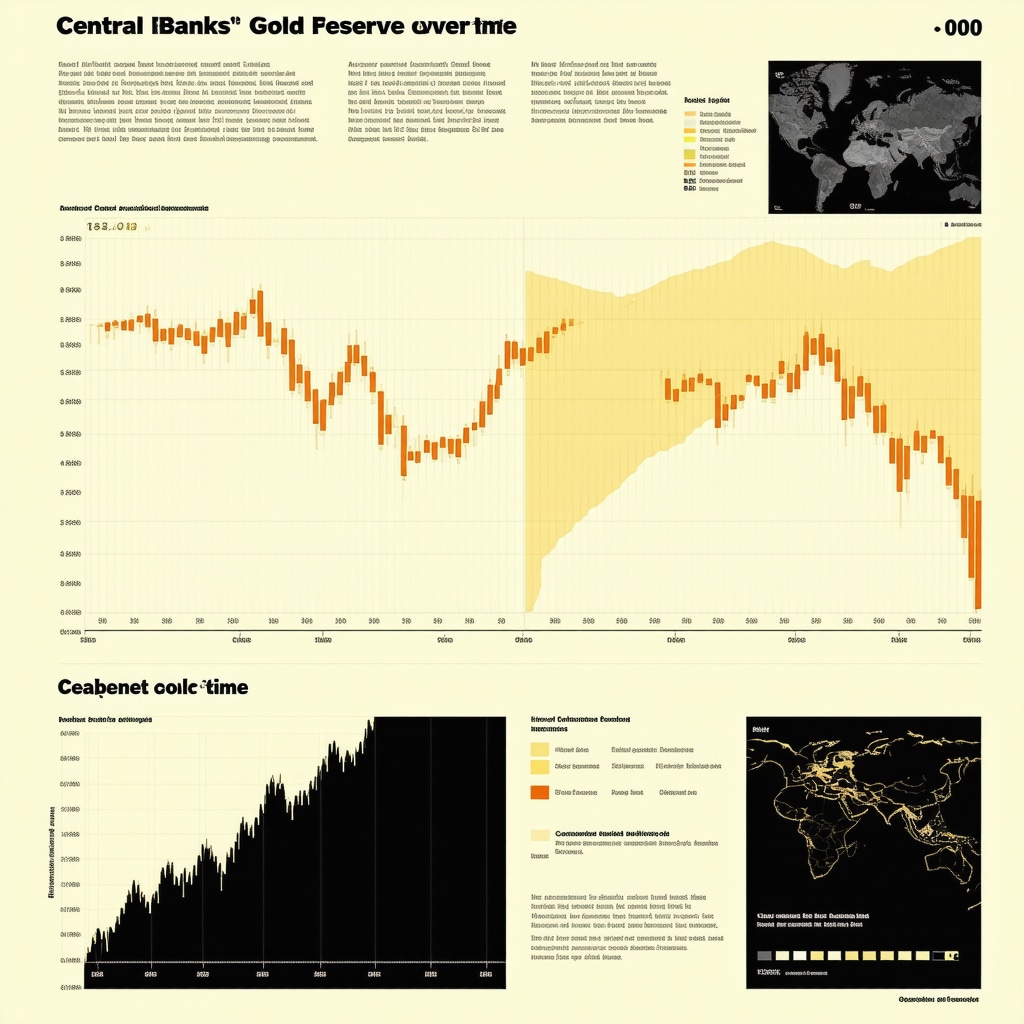Gold and the Grand Puppet Masters: Central Banks in the Spotlight
Imagine the gold market as a grand stage where every glimmering ounce tells a story of global intrigue and financial chess moves. In 2025, central banks are not just silent spectators but lead actors directing this glittering drama. With their strategic gold reserves purchases and sales, they wield enormous influence over gold prices, market sentiment, and even investor behavior worldwide.
Why Are Central Banks Hoarding Gold Like It’s the New Black?
Central banks historically turn to gold as a safe haven during uncertain economic times, but lately, their appetite seems insatiable. This frenzy stems from multiple factors: inflation worries, geopolitical tensions, and the desire to diversify away from traditional reserve currencies. Their moves send ripples through supply-demand dynamics, often jolting price trends in unexpected ways. Curious how these titans of finance balance their gold portfolios? Discover the latest insights on central bank gold purchases and their impact on 2025 prices.
Could Central Banks Be the Market’s Secret Gold Whisperers?
It’s tempting to think that these institutions possess a secret playbook controlling gold prices at will. While they certainly have clout, the reality is nuanced. Central banks influence gold market dynamics through measured buying and selling, often to stabilize their currencies or hedge against risks. However, their actions coexist with other complex forces such as private investment demand, mining outputs, and geopolitical shocks. The dance is intricate, and no single player holds all the cards.
When Central Banks Shift, Gold Markets Quiver
Take the example of the recent surge in central bank gold acquisitions reported by the World Gold Council—a credible authority on global gold trends. Their data highlights how these purchases, especially by emerging economies, have tightened gold supply and nudged prices upward. This trend aligns with investors eyeing gold as a shield against inflation and currency volatility. For a deeper dive into the interplay of supply and demand shaping gold’s future, explore global gold supply and demand analysis that every savvy investor should know.
The Ripple Effect: What It Means for You and Your Gold Portfolio
Central banks’ maneuvers aren’t abstract financial wizardry—they cascade down to affect everyday investors. Understanding how these giants shape market dynamics can empower you to make smarter investment decisions. Whether you’re contemplating physical gold bars, ETFs, or mining stocks, recognizing central bank trends offers a strategic edge. Curious about how to position yourself optimally in 2025’s gold market? Feel free to share your thoughts below or explore our expert analysis of gold price forecasts and market signals for 2025.
As we watch central banks weave their influence through the golden threads of the market, it’s clear that their role is pivotal. They may not control every shimmer and shadow, but their moves resonate powerfully, guiding the tides of gold prices and investor sentiment alike.
For those eager to understand the evolving gold market landscape, the insights from the World Gold Council remain an authoritative beacon illuminating these complex dynamics.
Decoding Central Banks’ Strategic Gold Moves: Beyond the Surface
Central banks’ gold transactions are often viewed as mere reserve adjustments, but their strategic significance runs much deeper. These institutions not only diversify reserves but also signal confidence or caution to global markets. Their activity frequently serves as a barometer for geopolitical stability, inflation expectations, and currency outlooks. For instance, a surge in gold buying by emerging market central banks often reflects a hedging strategy against dollar dependency and potential economic turbulence.
How Do Central Banks’ Gold Policies Influence Global Economic Stability?
When central banks adjust their gold reserves, the repercussions extend beyond commodity markets into broader economic landscapes. Increased gold holdings can bolster a nation’s financial sovereignty and reduce vulnerability to foreign exchange shocks. Conversely, sudden offloading of gold reserves might trigger volatility, unsettling investor confidence. These dynamics underscore the intricate link between monetary policy and precious metals markets, where gold acts as both a shield and a strategic asset.
Could Shifts in Central Bank Gold Reserves Signal Imminent Changes in Global Monetary Policy?
This question invites investors and analysts alike to scrutinize central bank behaviors as potential harbingers of macroeconomic shifts. For example, sustained accumulation of gold may presage a move away from fiat currencies or signal concerns over inflationary pressures. Conversely, strategic selling could indicate efforts to shore up liquidity or stabilize currency values amid economic stress. Understanding these patterns enhances foresight into market movements and informs portfolio allocation strategies.
According to recent analysis by the World Gold Council, central bank demand continues to be a primary driver in gold market dynamics, especially as countries seek to strengthen their financial resilience amid global uncertainties.
Positioning Your Investments Amid Central Bank Gold Trends
For investors keen on leveraging these insights, monitoring central bank gold activities can inform timing and asset selection. Diversifying holdings across physical gold, mining equities, and gold-backed ETFs may offer balanced exposure to potential price appreciation and risk mitigation. Additionally, staying updated on central bank announcements and geopolitical developments is crucial for proactive portfolio management.
To explore how these supply-demand interactions shape investment opportunities, consider reading our detailed guide on gold supply and demand insights for smarter investing.
We invite readers to share their perspectives on central banks’ role in the gold market and discuss strategies that have proven effective in navigating these complex dynamics. Your insights enrich the conversation and help build a more informed investing community.
The Subtle Art of Central Bank Gold Signaling: Deciphering Hidden Messages in Reserve Movements
Central banks rarely act without purpose, and their gold transactions often carry encrypted messages for global markets. These subtle cues can reflect shifts in monetary policy, reactions to geopolitical tensions, or strategic repositioning against currency risk. For example, a gradual increase in gold reserves by a major central bank might subtly indicate waning confidence in the US dollar’s dominance, prompting other nations and investors to reconsider their portfolio allocations.
Moreover, the timing and scale of these purchases are carefully orchestrated. Central banks avoid abrupt market disruptions, engaging in incremental acquisitions that cumulatively exert upward pressure on gold prices without triggering panic. This measured approach underscores the sophistication behind their gold strategies, revealing a blend of tactical patience and strategic foresight.
Interpreting Central Banks’ Gold Activity: What Financial Experts Are Saying
Leading economists and precious metals strategists emphasize that understanding central banks’ gold behaviors requires looking beyond headline numbers. As World Gold Council reports highlight, the qualitative aspects—such as which countries are buying, the geopolitical context, and currency stability—are equally critical. For instance, emerging market central banks have become prominent buyers, motivated by the desire to reduce reliance on the dollar and hedge against inflationary uncertainties.
How Do Central Banks Balance Gold Reserves with Currency Stability and Inflation Hedging?
This nuanced balancing act involves complex considerations. Central banks must weigh gold’s benefits as a non-yielding asset against its role as a safeguard against currency devaluation and inflation. When inflation expectations rise, gold’s appeal as an inflation hedge intensifies, pushing central banks to increase holdings. Conversely, in periods of stable inflation and strong currency performance, central banks might moderate their gold acquisition pace, reallocating resources to other reserve assets.
Understanding this dynamic helps investors anticipate market shifts. For example, a central bank increasing gold reserves amid rising inflation signals potential future currency volatility, prompting investors to consider gold as a protective asset. This interplay highlights the importance of monitoring central bank communications and economic indicators simultaneously.
Gold Supply Constraints and Central Bank Demand: Navigating the Delicate Equilibrium
While central banks ramp up gold acquisitions, the global supply side faces inherent constraints. Mining output has plateaued in recent years, and recycled gold supply fluctuates, limiting availability. This supply-demand squeeze often translates into increased volatility and sustained price support. The World Gold Council’s detailed analyses underscore how these supply constraints amplify central bank impacts on gold pricing.
For investors, this means that central bank demand can act as a powerful catalyst, particularly when combined with limited incremental supply. Anticipating these supply-demand imbalances can be crucial for timing entries and exits in the gold market.
Strategic Portfolio Positioning: Leveraging Central Bank Trends for Enhanced Gold Investment Decisions
Incorporating central bank activity insights into portfolio strategy demands a multifaceted approach. Diversification remains paramount, mixing physical bullion, ETFs, and selective mining equities to capture various risk-return profiles. Monitoring central bank disclosures, geopolitical developments, and inflation metrics enables investors to adjust their gold exposure proactively.
Moreover, advanced investors might explore derivative instruments such as gold futures and options to hedge or capitalize on anticipated market moves driven by central bank signals. However, these instruments require sophisticated understanding and risk management discipline.
For those committed to mastering these complexities, our comprehensive resource on gold supply and demand insights for smarter investing offers in-depth guidance tailored to navigating this intricate landscape.
We encourage readers to engage with this evolving dialogue—share your analytical perspectives on central bank gold dynamics and their implications for portfolio management. Together, we can deepen our collective expertise and refine investment approaches in an ever-changing gold market.
Decoding the Unseen Signals: How Central Banks’ Gold Reserve Moves Foretell Economic Shifts
Central banks’ gold transactions often act as a cryptic language, subtly conveying their macroeconomic outlooks and strategic priorities. These movements, while measured and incremental, can foreshadow significant shifts in global monetary policy frameworks. For investors with a keen eye, interpreting these signals is crucial to anticipating market turns before they become mainstream narratives.
Take, for instance, the nuanced gold accumulation patterns by emerging market central banks. These are not mere reserve diversification exercises but deliberate hedges against anticipated currency devaluations and inflationary spirals. The International Monetary Fund’s recent working paper underscores how such gold reserve strategies can signal diminishing confidence in existing fiat currencies and a tilt towards tangible asset backing.
How Do Central Banks’ Gold Reserve Strategies Interact with Emerging Geopolitical Tensions and Currency Wars?
This question probes the intricate interplay between geopolitical dynamics and central bank gold policies. As nations grapple with escalating currency wars and trade tensions, gold emerges as a geopolitical risk hedge. Central banks’ strategic gold purchases often coincide with periods of heightened geopolitical uncertainty, serving as a buffer against sanctions, supply chain disruptions, and capital flight risks. Understanding this interplay equips investors to contextualize gold price movements beyond traditional economic indicators.
Leveraging Central Bank Gold Trends: Advanced Portfolio Positioning for Sophisticated Investors
For those ready to elevate their investment strategy, integrating central bank activity insights into portfolio construction can unlock alpha opportunities. This involves not only tracking purchase volumes but also analyzing the geopolitical and macroeconomic contexts driving these moves. Diversification across physical gold, premium mining equities, and actively managed gold funds can harness different facets of gold’s market behavior.
Moreover, advanced investors might consider tactical use of derivatives like gold futures and options to hedge exposure or speculate on anticipated central bank-driven price shifts. However, this requires rigorous risk management and market timing expertise.
For a comprehensive framework on these strategies, explore our detailed guide on gold supply and demand insights for smarter investing, which delves into the nuanced factors shaping gold’s price trajectory in 2025.
Will Central Banks’ Gold Maneuvers Reshape the Future of Global Reserve Currencies?
The prospect of central banks increasingly favoring gold raises profound questions about the future architecture of international finance. Could sustained gold accumulation herald a gradual erosion of the US dollar’s primacy, nudging the global economy towards a more multipolar reserve system? Or might it catalyze renewed interest in gold-backed digital currencies and alternative monetary frameworks?
Financial experts from institutions like the World Gold Council emphasize that while gold’s role as a reserve asset is resurgent, its evolution will depend on broader geopolitical alignments, technological innovations, and policy decisions. Investors should therefore monitor central bank gold activity as a critical barometer for these transformative trends.
We invite you to share your perspectives on how central bank gold strategies influence your investment approach and to join the conversation on emerging market signals shaping 2025’s gold landscape. Your insights enrich this dialogue and empower smarter, more agile investment decisions.

Expert Insights & Advanced Considerations
Central Banks as Strategic Market Signalers, Not Just Buyers
Beyond their reserve accumulation, central banks use gold transactions as nuanced signals to global markets. These moves often reflect deeper macroeconomic intentions—hedging against currency risks, responding to inflation expectations, or signaling geopolitical caution. Recognizing these patterns helps sophisticated investors anticipate shifts before they materialize in price action.
The Supply Squeeze Amplifies Central Bank Impact on Gold Prices
With mining output plateauing and recycled gold supply fluctuating, central bank purchases increasingly strain available supply. This imbalance creates a potent catalyst for sustained price appreciation and volatility. Investors mindful of these constraints can better time their entries and adjust portfolios to capture value amid tightening supply-demand dynamics.
Diversification Across Gold Assets Enhances Risk-Adjusted Returns
Given the complex interplay of central bank policies, geopolitical tensions, and market sentiment, diversifying across physical bullion, ETFs, and premium mining stocks is key. This approach captures different exposure angles—direct ownership, liquidity, and leveraged growth—while managing risk in a volatile environment shaped by sovereign actions.
Derivative Instruments Offer Tactical Leverage but Demand Expertise
For advanced investors, gold futures and options present opportunities to hedge or speculate on central bank-driven price shifts. However, this requires sophisticated market understanding and risk controls. Proper use of derivatives can enhance portfolio flexibility but must be approached with disciplined strategy.
Monitoring Emerging Market Central Banks Provides Early Warning Signals
Emerging economies’ gold reserve strategies often presage broader monetary policy and geopolitical developments. Their increasing appetite for gold reflects shifting confidence in fiat currencies and rising inflation hedging needs. Staying attuned to these trends enriches an investor’s macroeconomic perspective and informs tactical positioning.
Curated Expert Resources
- World Gold Council (https://www.gold.org/about-gold-supply-demand): The definitive source for comprehensive gold supply-demand data and authoritative market analysis, essential for understanding central bank influences.
- International Monetary Fund Working Paper on Central Bank Gold Reserves (https://www.imf.org/en/Publications/WP/Issues/2023/06/15/Central-Bank-Gold-Reserves-and-Monetary-Policy-Implications-536987): Expert research linking gold reserve strategies to monetary policy and economic stability, offering deep macroeconomic context.
- BuyingGoldNow’s Gold Supply and Demand Insights (https://buyingoldnow.com/gold-supply-and-demand-insights-for-smarter-investing): A practical guide for investors to decode gold market dynamics and leverage supply-demand trends for smarter investment decisions.
- Gold Price Forecasts and Market Signals for 2025 (https://buyingoldnow.com/2025-gold-price-forecast-experts-reveal-key-market-signals): Expert analysis that ties central bank activity to near-term price projections and strategic investment positioning.
- Effective Gold Trading Strategies for Volatile Markets (https://buyingoldnow.com/effective-gold-trading-strategies-for-volatile-markets): Tactical approaches to navigating gold price swings influenced by sovereign reserve shifts and geopolitical events.
Final Expert Perspective
Central banks’ gold reserve maneuvers are far more than passive portfolio adjustments—they are deliberate strategies imbued with geopolitical, economic, and monetary significance. Their actions reverberate through the gold market, shaping price trajectories and signaling broader financial currents. For investors aiming to master the complexities of gold supply and demand in 2025, integrating these insights into portfolio strategy is indispensable. Understanding this sophisticated dance offers a competitive edge, enabling more informed, agile investment decisions.
Engage with this evolving dialogue by exploring expert gold price forecasts and market signals for 2025, refining your strategy with nuanced supply-demand knowledge from gold supply and demand insights for smarter investing, and sharing your professional perspectives. The gold market’s story is written by those who read its subtle cues best—will you be among them?










